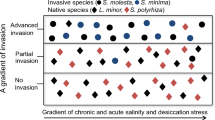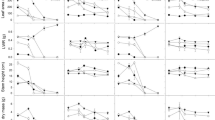Abstract
With projected increase in storms, sea-level rise and saltwater intrusion in low-lying terrestrial areas, compositional changes that favor more salt tolerant species are likely to occur. Wetland species are expanding into declining forested communities, primarily dominated by trees. Higher salinities for germination may preclude establishment of tree species. We examined the capacity for coastal tree species (Acer rubrum, Liquidambar styraciflua, Pinus taeda, Celtis occidentalis, Persea borbonia) and a wetland shrub (Morella cerifera) to germinate at salinity concentrations of 0, 2, 5, 10, and 20 ppt. A growth chamber experiment was established examining the effect of salinity on germination of common species found in mixed forests throughout the mid-Atlantic coastal plain and Gulf of Mexico, USA. The study revealed that regeneration from seed will be difficult for most of the selected species at salinities >5 ppt with implications for community composition with continued saltwater intrusion. Germination of A. rubrum was not impacted at higher salinities, with Pinus taeda not as affected other species. Morella cerifera did not have an advantage at the germination stage over selected tree species. Knowing threshold limits of germination response to salinity is critical for identifying future community trajectories.





Similar content being viewed by others
References
Ash JD, Givnish TJ, Waller DM (2017) Tracking lags in historical plant species’ shifts in relation to regional climate change. Global Change Biology 23:1305–1315
Battaglia LL, Denslow JS, Hargis TG (2007) Does woody species establishment alter herbaceous community composition of freshwater floating marshes? Journal of Coastal Research 23:1580–1587
Bellis VJ, Keough JR (1995) Ecology of maritime forests of the southern Atlantic Coast: a community profile. U.S. Department of Interior, Washington, DC
Bochet E (2015) The fate of seeds in the soil: a review of the influence of overland flow on seed removal and its consequences for the vegetation of arid and semiarid patchy ecosystems. Soil 1:131–146
Conner WH (2007) Ecology of tidal freshwater forested wetlands of the southeastern United States Dordrecht: springer pp 448-450
Conner WH, Askew GR (1993) Impact of saltwater flooding on red maple, redbay, and Chinese tallow seedlings. Castanea pp 214-219
Conner WH, Mixon WD, Wood GW (2005) Maritime forest habitat dynamics on bulls island cape Romain National Wildlife Refuge, S. C., following hurricane Hugo. Forest Ecology and Management 212:127–134
DeSantis LR, Bhotika S, Williams K, Putz FE (2007) Sea-level rise and drought interactions accelerate forest decline on the Gulf coast of Florida, USA. Global Change Biology 13:2349–2360
Donohue K, de Cosas RR, Burghardt L, Kovach K, Willis CG (2010) Germination, post germination, adaptation and species ecological ranges. Annual Review of Ecology, Evolution, and Systematics 41:293–319
Doyle TW, Krauss KW, Conner WH, From AS (2010) Predicting the retreat and migration of tidal forests along the northern Gulf of Mexico under sea-level rise. Forest Ecology and Management 259:770–777
Ehrenfeld JG (1990) Dynamics and processes of barrier-island vegetation. Reviews in Aquatic Sciences 2:437–480
Fagherazzi S, Anisfeld SC, Blum LK, Long E., Feagin RA, Fernandes A, Kearney, WS, Williams K. (2019) Sea level rise and the dynamics of the marsh-upland boundary. Frontiers in environmental science 7 article 25
Fernandes A, Rollinson CR, Kearney WS, Dietze MC, Fagherazzi S (2018) Declining radial growth response of coastal forests to hurricanes and nor'easters. Journal of Geophysical Research: Biogeosciences 123:832-849
Field CR, Gjerdrum C, Elphick CS (2016) Forest resistance to sea-level rise prevents landward migration of tidal marsh. Biological Conservation 201:363–369
Flint HL (1985) Plants showing tolerance of urban stress. Journal of Environmental Horticulture 3:85–89
Fraaije RG, ter Braak CJF, Veryuyn B, Breeman LBS, Verhoven JTA, Soons MB (2015) Early plant recruitment stages set the template for the development of vegetation patterns along a hydrological gradient. Functional Ecology 29:971–980
Gilman, EF and Watson, DG, 1993. Celtis occidentalis common hackberry. Available: n http://hort. Ufl. Edu/database/documents/pdf/tree_fact_sheets/celocca. Pdf
Gilman, EF; Watson, DG, 1994. Persea borbonia Redbay. Available: n http://hort.ufl.edu/trees/PERBORA.pdf
Hallett R, Johnson ML, Sonti NF (2018) Assessing the tree health impacts of saltwater flooding in coastal cities: a case study in New York City. Landscape and Urban Planning 177:171–177
Hayden BP, Hayden NR. (2003) Decadal and century-long changes in storminess at long- term ecological research sites. Climate Variability and Ecosystem Response at Long- Term Ecological Research Sites. Oxford University Press, New York, NY, USA, pp.262–285
Hoagland DR, Arnon DI (1950) The water-culture method for growing plants without soil. Circular. California Agricultural Experiment Station 347 2nd ed.
Huang H, Zinnert JC, Wood LK, Young DR, D’Odorico P (2018) Non-linear shift from grassland to shrubland in temperate barrier islands. Ecology 99:1671–1681
Johnson SR, Young DR (1993) Factors contributing to the decline of Pinus taeda on a Virginia barrier island. Bulletin of the Torrey Botanical Club 120:431–138
Johnstone JF, Allen CD, Franklin JF, Frelich LE, Harvey BJ, Higuera PE, Mack MC, Meentemeyer RK, Metz MR, Perry GL, Schoennagel T (2016) Changing disturbance regimes, ecological memory, and forest resilience. Frontiers in Ecology and the Environment 14:369–378
Kirwan ML, Gedan KB (2019) Sea-level driven land conversion and the formation of ghost forests. Nature Climate Change 9:450–457
Kirwan ML, Temmerman S, Skeehan EE, Guntenspergen GR, Fagherazzi S (2016) Overestimation of marsh vulnerability to sea level rise. Nature Climate Change, 6:253. Kormanik P. 1990. Liquadambar styraciflua, sweetgum. In: Silvics of North America: 2. Hardwoods. Burns, R.M., and B.H. Honkala, Tech. Coords. http://www.na.fs.fed.us/ Arboriculture & Urban Forestry 33(2): March 2007 95 ©2007 International Society of Arboriculture spfo/pubs/silvics_manual/table_of_contents.htm (accessed 3/8/06) Agriculture Handbook 654 Vol. 2 of the USDA Forest Service, Washington, DC. 877 pp.
Kormanik PP (1990) Liquidambar styraciflua L. sweetgum. Silvics of North America 2:400–405
Langston AK, Kaplan DA, Putz F (2017) A casualty of climate change? Loss of freshwater forest islands on Florida’s Gulf Coast. Global Change Biology 5383–5397
Liu X, Conner WH, Son B, Jayakaran AD (2017) Forest composition and growth in a freshwater forested wetland community across a salinity gradient in South Carolina, USA. Forest Ecology and Management 389:211–219
Lugo AE (2008) Visible and invisible effects of hurricanes on forest ecosystems: an international review. Austral Ecology 33:368–398
Martin DW, Young DR (1997) Small-scale distribution and salinity response of Juniperus virginiana on an Atlantic Coast barrier island. Canadian Journal of Botany 75:77–85
McNair JN, Sunkara A, Frobish D (2012) How to analyse seed germination data using statistical time-to-event analysis: non-parametric and semi-parametric methods. Seed Science Research 22:77–95
Middleton BA (2016) Differences in impacts of hurricane Sandy on freshwater swamps on the Delmarva Peninsula, mid-Atlantic Coast, USA. Ecological Engineering 87:62–70
Naumann JC, Young DR, Anderson JE (2008) Leaf chlorophyll fluorescence, reflectance, and physiological response to freshwater and saltwater flooding in the evergreen shrub, Myrica cerifera. Environmental and Experimental Botany 63:402–409
Paudel S, Battagilia LL (2013) Germination responses of the invasive Triadica sebifera and two co-occurring native woody species to elevated salinity across a gulf coast transition ecosystem. Wetlands 33:527–535
Paudel S, Battaglia LL (2015) The role of light, soil and human factors on the probability of occurrence of an invasive and three native plant species in coastal transitions of coastal Mississippi, USA. Journal of Plant Ecology 8:491–500
Pezeshki SR (1992) Response of Pinus taeda L to soil flooding and salinity. In: Annales des sciences forestières EDP Sciences, vol 49, pp 149–159
Ranal MA, Santana DGD, Ferreira WR, Mendes-Rodrigues C (2009) Calculating germination measurements and organizing spreadsheets. Brazilian Journal of Botany 32:849–855
Rey PJ, Alcántara JM (2000) Recruitment dynamics of a fleshy-fruited plant (Olea europaea): connecting patterns of seed dispersal to seedling establishment. Journal of Ecology 88:622–633
Sallenger AH, Doran KS, Howd PA (2012) Hotspot of accelerated sea-level rise on the Atlantic coast of North America. Nature Climate Change 2:884–888
Schieder NW, Walters DC, Kirwan ML (2018) Massive upland to wetland conversion compensated for historical marsh loss in Chesapeake Bay, USA. Estuaries and Coasts 41:940–951
Schultz RP. 1997. Loblolly pine: the ecology and culture of loblolly pine (Pinus taedaL.). Agriculture handbook 713. Washington, DC: US Department of Agriculture, Forest Service. 493 p
Thomas BL, Doyle T, Krauss K (2015) Annual growth patterns of baldcypress (Taxodium distichum) along salinity gradients. Wetlands 35:831–839
Walck JL, Hidayati SN, Dixon KW, Thompson K, Poschlod P (2011) Climate change and plant regeneration from seed. Global Change Biology 17:2145–2161
Wells BW, Shunk IV (1938) Salt spray: an important factor in coastal ecology. Bulletin of the Torrey Botanical Club 65:485–493
Williams SJ (2013) Sea-level rise implications for coastal regions. Journal of Coastal Research 63:184–196
Woods NN, Dows BL, Goldstein EB, Moore LJ, Young DR, Zinnert JC (2019) Interaction of seed dispersal and environmental filtering affects woody encroachment patterns in coastal grassland. Ecosphere 10(7), p.e02818
Young JA, Young CG (1992) Seeds of Woody plants in North America. Dioscorides Press, Portland
Zinnert JC, Shiftlett SA, Vick JK, Young DR (2011) Woody vegetative cover dynamics in response to recent climate change on an Atlantic Coast barrier island: a remote sensing approach Geocarto International 26:595–612
Acknowledgments
This work was supported by the National Science Foundation Long-Term Ecological Research grants DEB-1237733 and DEB-1832221 to JC Zinnert and Ford Foundation Fellowship to NN Woods. The authors thank Amanda Faucette from North Carolina Botanical Garden at the University of North Carolina at Chapel Hill for providing seeds, the Virginia Coast Reserve staff for logistical support, Dot Field with the Virginia Department of Conservation and Recreation for permitted access to collect seeds on the eastern shore of Virginia and Caitlin Bishop, Joe Brown, Lauren Wood, Austin Tuley, Michael Sinclair, Audrey Kirschner, Eddie Long and Caroline Baucom for technical support.
Author information
Authors and Affiliations
Corresponding author
Additional information
Publisher’s Note
Springer Nature remains neutral with regard to jurisdictional claims in published maps and institutional affiliations.
Rights and permissions
About this article
Cite this article
Woods, N.N., Swall, J.L. & Zinnert, J.C. Soil Salinity Impacts Future Community Composition of Coastal Forests. Wetlands 40, 1495–1503 (2020). https://doi.org/10.1007/s13157-020-01304-6
Received:
Accepted:
Published:
Issue Date:
DOI: https://doi.org/10.1007/s13157-020-01304-6




